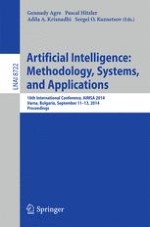2014 | Buch
Artificial Intelligence: Methodology, Systems, and Applications
16th International Conference, AIMSA 2014, Varna, Bulgaria, September 11-13, 2014. Proceedings
herausgegeben von: Gennady Agre, Pascal Hitzler, Adila A. Krisnadhi, Sergei O. Kuznetsov
Verlag: Springer International Publishing
Buchreihe : Lecture Notes in Computer Science
